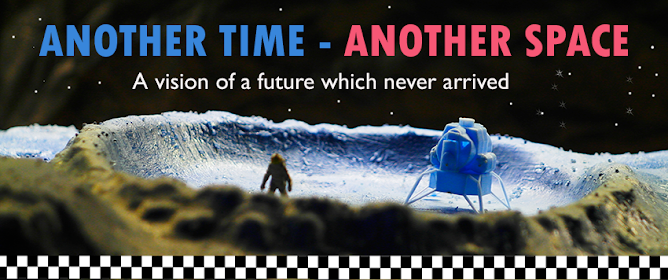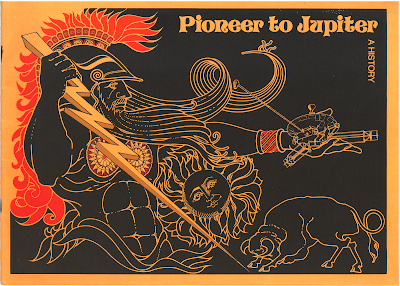Starting in 1958, the series of Pioneer probes was divided into two main sections, with the early attempts to study the moon and later probes aimed towards Venus and the outer planets. The early missions were beset with failure, as launch vehicles caused problems at take off and when Pioneer 3 finally achieved escape velocity, it missed the Moon entirely. It wasn't until the launch of Pioneer 6 in 1965, that the US began to see positive results, as probes were dispatched to orbit the sun and study space weather. However, the Jupiter bound missions 10 and 11 which launched in 1972/3 respectively, were the most successful, as besides reaching their remote destination, the probes achieved sufficient velocity to allow them to later leave the Solar System entirely.
This rare booklet by TRW Industries commemorates the launch of Pioneer 10 and looks forward towards its encounter with the gas giant Jupiter.The probe was designed to study the gas giant and was not expected to remain functional following its exposure to Jupiter's high radiation output. Some of the cameras and equipment did succumb to the extreme environments, but overall, the probe was way more successful than its designers could have imagined.

Carl Sagan was an astronomer and planetary scientist, who advocated the inclusion of a 'golden record' and a plaque containing informational graphics which might be accessible by intelligent life in outer space. The idea of the plaque was met with criticism by the general public and TRW held a competition for ideas for information to be included on the mision.

As the probe approached and successfully encountered Jupiter, the idea of a Grand Tour of the Solar System was suggested, to take advantage of the future planetary positions of the major outer planets. This would eventually become the Voyager mission.
The following year, the companion probe 11 was launched, with the intention of repeating Pioneer 10's successful encounter, before moving on to explore Saturn.
After the success of the two probes initial missions, both craft subsequently went on to pass the orbits of Neptune and Pluto, to moving into interstellar space, becoming the first man made objects to leave the solar system.
Final contact with Pioneer 10 was made as the onboard power ultimately failed, in 2003, with a faint signal being recorded by the Deep Space network as the probe disappeared into the unknown.


Early in the 1960's, the idea of the Grand Tour was , for a planetary exploration of the gas giants Jupiter and Saturn and their moons and the ice giants Uranus and Neptune, to take advantage of a once in 175 years conjunction and employing gravity assists for the probes.
With the success of the Pioneer Jupiter missions, a Mariner probe design was to be refitted for the next mission to visit the outer system and it was only late in the programme that it was suggested that the probe be renamed Voyager.
Using a similar shaped vehicle to Pioneer, two Mariner probes were prepared for launch in 1972, before being renamed some years later, prior to launch in 1977, with an initial remit to visit Jupiter and Saturn only.
Voyager 2 launched first, although it would reach its destination after Voyager 1, encountering Jupiter in 1979. The probes also took advantage of close fly-bys of the moons of Ganymede and Io. Both carried the same plaque as Pioneer, but also a 'golden record' disk with sounds of Earth and people speaking different languages, in the remote possibility that the probe might be intercepted by intelligent life.
The Voyager programme exceeded their expectations and life expectancy, outliving their own inventors and designers. Some of the images returned by the probes are still being examined and processed today and gave us the closest views of the gas giants and their moons. The probes passed the previous Pioneer probes in the mid 1990's, becoming the farthest man made objects in space as they embarked on the extended Interstellar Mission. Voyager 1 is now over 15 billion miles away and will log 47 years in space this year and is still returning useable data. Voyager 2 is 13 billion miles away and currently experiencing a pause in communications, as the antenna has become misaligned.
Some of the imagery returned by the probes gave resident NASA artists inspiration for artwork in support of the mission, which is contained in a large volume 'Nasa and the Exploration of Space' which holds a wealth of wonderful paintings and drawings from the beginnings of the administration to the present, illustrating launches, landings, planetary scenes and mission activities from all points in history.
The Pioneer and Voyager images would remain the premier source of information on the outer planets for many years, until the probes Cassini and Galileo reached the gas giants and paved the way for further missions such as New Horizons and very shortly the Europa Clipper.
























